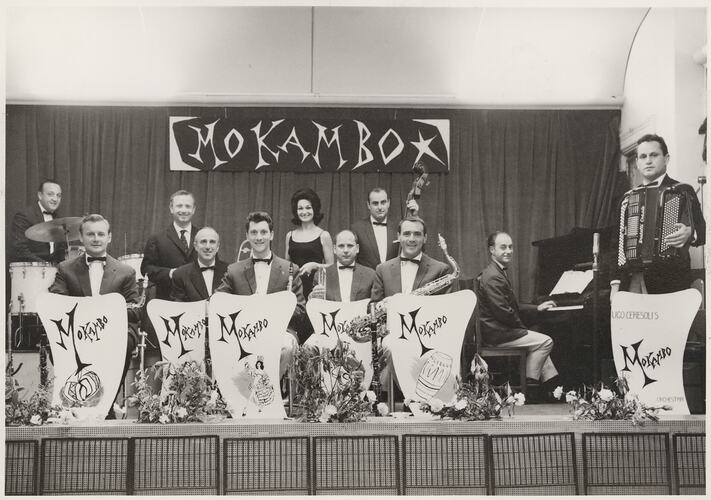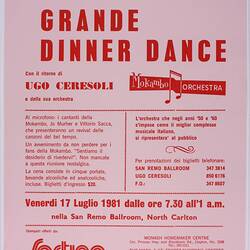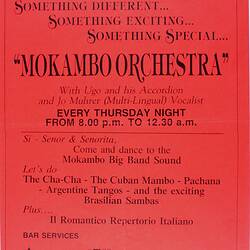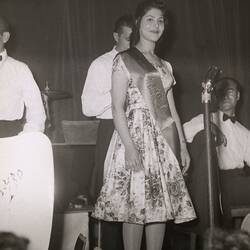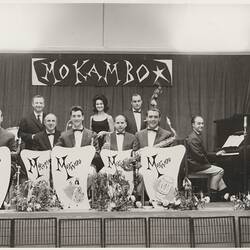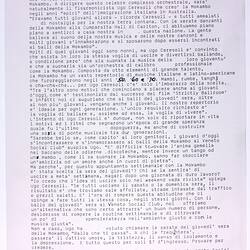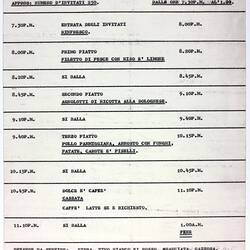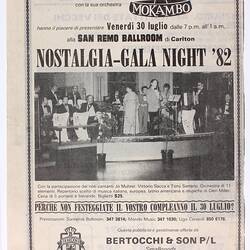Summary
The Mokambo Orchestra band was formed in 1953, by brothers Ugo and Bruno Ceresoli, in the post-War Italian migrant community of Melbourne. The band performed Italian, Latin and other music styles for increasingly cosmopolitan Melbourne audiences over a period of forty years and was an integral part of the growing Italian community of Carlton.
The Mokambo Orchestra band was formed in 1953, by brothers Ugo and Bruno Ceresoli, in the post-war Italian migrant community of Melbourne, Victoria. The band performed Italian, Latin and other music styles for increasingly cosmopolitan Melbourne audiences over a period of forty years and was an integral part of the growing Italian community of Carlton. The formation of numerous Italian-Latino bands playing 'ballo Italiano' led to the popularisation of this style with both Italian communities and the broader public.
Ugo Ceresoli (1927-1996) emigrated from Emilia-Romagna, Italy, to Australia, arriving in Melbourne in 1952 on the 'Oceania' (Dell'oso, 2000). He was reunited with his older brother Bruno (1925-1970) who had arrived in Melbourne three years earlier. Ugo was 25 years old and an accomplished dance musician and accordionist. Bruno's interests lay with the guitar and he was considered the businessman of the family (ibid, 2000). In 1953, after performing on the radio and at concerts as an instrumental duo, the Ceresoli brothers formed a band, which they titled the 'Mokamba Orchestra', probably based on the 1953 Hollywood film, 'Mogambo' (Ercole, 1981 quoted in Whiteoak, 2007).
A studio photograph featuring many of the Mokambo Orchestra's founding members was taken at the Torino Studios reception room in 1960. The photograph featured Ugo Ceresoli (button accordion), Ken Whitburn (piano), Alberto Caselli (alto saxophone, not an original member), Nino Cabrera (trumpet), Renzo Conte (drums), Franco Incerti (tenor saxophone), Pietro Alessi (cantante) and Bruno Ceresoli (bass guitar). Later additions to the band included Giuseppe Alessandrello (replacing Bruno on bass guitar) and Alberto Caselli (clarinet) (Caselli, 2011).
The music and dances of The Mokambo Orchestra brought 'a bit of air in the home to many Italian immigrants who settled in Melbourne' (Ercole, 1981), appealing to the often homesick Italian migrants during difficult years of emigration and settlement into the Victorian community.
Ugo and the Mokambo Orchestra performed on many radio stations, including 3XY, 3UZ, 3KZ, 3DB, and 3GL and conducted a Cabaret-style musical programme on 3EA, Ethnic Radio, on Saturday mornings (Ceresoli, 1983). They drew a generation of Italian post-war migrants to Carlton's Cumparsita ballroom (also known as Mokambo Hall) on a weekly basis. Other regular venues included Fitzroy Town Hall, San Remo Ballroom at 365 Nicholson Street North Carlton, and the Circolo Italiano Cavour (Cavour Club) in South Melbourne. The 'balli Italiano' were popular events for members of the Italian community. Many young Italian-Australians met at Cumparsita Hall and 'many marriages originated in those long Sunday afternoons' (Ercole, 1981).
By the mid-fifties, the Ceresoli brothers decided to use the Mokambo Orchestra to branch into different revenue streams, such as the annual 'Miss Mokambo Beauty Pageant' at La Cumparsita Hall. The earliest photograph of a 'Miss Mokambo' event dates back to 1959 (IHS, 1959). From 1959 they also ran the light-hearted annual 'Mister Brutto' ('Mister Ugly') quest (Whiteoak, 2007). In 1961 the Moomba festival organisers decided to include groups from immigrant communities in the festival line-up and featured the Mokambo Orchestra (M.A.T.I.A Music, 1987).
The Mokambo Orchestra disbanded in 1970 after the sudden death of Bruno. Ugo spent this time focusing on his store, Mondo Music, in Lygon Street and writing music for several competitions. By 1982 Ugo was ready to reform the Mokambo Orchestra and held a 'Riunione nostalgica della Mokambo' (M.A.T.I.A Music, 1987), for which he assembled the available band members and booked the San Remo Ballroom in Carlton. The night was popular with the nostalgic Italian community and led to a series of comeback performances.
Regrettably, the Mokambo Orchestra never released a record and the Latin-Italian sounds of the Mokambo Orchestra now 'lives and resonates only in the minds of the rapidly dwindling number of people who actually heard and danced to it' (Whiteoak, 2007). Ugo Ceresoli and the Mokambo Orchestra played for a period of over forty years, with a twelve year hiatus in the seventies, but each time they returned to perform 'it was as if it were the first time' (Delfi, 1991).
References
Australian Death Index 1787 - 1985. (1970). Bruno Ceresoli. Australian Death Index 1787 - 1985.
Caselli, A. (2011) 'Letter to Editor' Italian Historical Society, Vol. 19, p. 5
Ceresoli, U. (1983, October 6). Melbourne Duo in Italian Festival of Songs Win. News Release. Melbourne, Victoria, Australia: Ugo Ceresoli.
Delfi, J. (1991, November 8). Ugo Ceresoli, la Mokambo e il "ballo anti-recessione". Il Mondo, p. 25.
Dell'oso, A. M. (2000). Exploring Identity and Community Through the Arts and Culture. Panel Discussion: Exploring Identity and Community Through the Arts and Culture (pp. 797 - 839). Victoria: The Italian Australian Institute at La Trobe University.
Ercole, I. (1981, June 8). Ugo Ceresoli e l'orchestra Mokambo di nuovo in pedana dopo 12 anni. Il Globo, n.p.
Italian Historical Society (1959) 'The Miss Mokambo Beauty Pageant at La Cumparsita Hall'. Co.As.It - Italian Historical Society, Carlton, Victoria. Retrieved April 1, 2014, from: http://www.coasit.com.au/dbtwwpd/exec/dbtwpub.dll?BU=&TN=IHSnew&RF=Web%3EIHSfull&MR=&AC=QBE_QUERY&CS=2&QY=Number%3D+P-00975
La Fiamma. (1982, August 1). Sull'onda della nostalgia con la nuova orchestra Mokambo. La Fiamma, n.p.
M.A.T.I.A Music (1987). Ugo Ceresoli. M.A.T.I.A Music, pp. 30 - 34.
Museum Victoria (2014). Ugo Ceresoli and the Mokambo Orchestra Studio Photograph [Original]. DOI: MM137265
Whiteoak, J. (2007). Mambo Italiano: Ugo Ceresoli and His Orchestra Mokambo. Italian Historical Society Journal, 58-72.
More Information
-
Keywords
-
Authors
-
Article types
